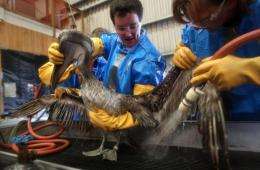BP says tube is containing one fifth of oil spill

BP said Monday that about 20 percent of the oil gushing into the Gulf of Mexico is being swallowed up by its insertion tube system, no longer feeding a giant slick off Louisiana.
But the British energy giant's first concrete success in almost a month of efforts to tackle the spill risked being overshadowed by fears that huge underwater plumes of crude could be starving the waters of oxygen.
"BP is burying its head in the sand on these underwater threats," said Democratic congressman Ed Markey.
"These huge plumes of oil are like hidden mushroom clouds that indicate a larger spill than originally thought and portend more dangerous long-term fallout for the Gulf of Mexico's wildlife and economy."
A research vessel located last week massive plumes up to 10 miles (16 kilometers) long, three miles wide and 300 feet thick that suggested a far greater impact on the marine environment than previously thought.
"Normally, in a shallow spill, everything pretty much shoots up to the surface and the impacts are primarily to surface organisms like turtles, dolphins, whales and birds," explained Doctor Paul Montagna.
The expert from the Harte Research Institute for Gulf of Mexico Studies at Texas A&M University-Corpus Christi said deepwater spills were a relatively new phenomenon that posed greater risks due to these plumes.
"What happens is we're dealing with a different kind of situation than the past because under this really cold, high pressure environment the oil is getting dispersed through the water column," he told AFP.
"What that means is that basically life in the entire water column is now being exposed. The dispersants themselves are toxic as well. We have organisms being exposed to a lot of toxic materials."
Response crews have so far used some 560,000 gallons of controversial chemical dispersants, spraying them onto surface oil and also directly into the leak in a bid to break up the oil.
After almost a month of coming under increasing fire for failing to stem an estimated 5,000 barrels, or 210,000 gallons, of oil spewing into the Gulf every day, BP enjoyed its first taste of success at the weekend, albeit limited.
A tube with a four-inch diameter was inserted by robotic submarines into the main leak and connected via a mile-long pipe to the Discoverer Enterprise, a drill ship on the surface which can process the oil and residual gases safely.
BP said the short length of tube, 5,000 feet (1,500 meters) down on the seabed, had sucked up about 1,000 barrels of oil in its first day of operations and that it hoped to increase the rate as the week progressed.
The system allows for injections of methanol to stop gas hydrates forming, but engineers warned that if they try to increase the rate too quickly and too much seawater got in, the tube could become clogged with ice-like crystals.
"There's still oil coming out," BP chief operating officer Doug Suttles told CNN. "But what we hope to do over the next 24 hours is continue to... increase the rate coming out of that insertion tube and capture more and more of the flow."
US President Barack Obama administration seemed unimpressed, however, saying BP's efforts, even if they manage to slow the leak, would not permanently stop the underwater geyser.
"This technique is not a solution to the problem, and it is not yet clear how successful it may be," said Homeland Security Secretary Janet Napolitano and Interior Secretary Ken Salazar.
Significant breakthrough or not, with dozens of lawsuits pending and a permanent fix still a while off, the development is unlikely to alleviate much of the pressure on BP.
Congressional hearings have revealed multiple warning signs that were overlooked before the April 20 blast on the BP-leased Deepwater Horizon rig.
The indicators of things being wrong included a key pressure test that failed during final operations to seal the well being drilled about 50 miles (80 kilometers) offshore.
Two days later the rig sank and the blowout preventer -- a giant valve designed to shut off the flow of oil -- failed.
Engineers are mulling several different options to seal the main leak which has spewed out an estimated five million gallons so far.
First could be a "junk shot" maneuver to jam up the blowout preventer with golf balls, tires, rope and other debris, followed by a "top kill" to permanently seal the well by injecting heavy drilling mud and then cement.
Meanwhile, stricken communities along the southern Gulf coast have already seen their livelihoods hit by a fishing ban, as sheen washes up on islands off Louisiana, Alabama and Mississippi.
(c) 2010 AFP



















